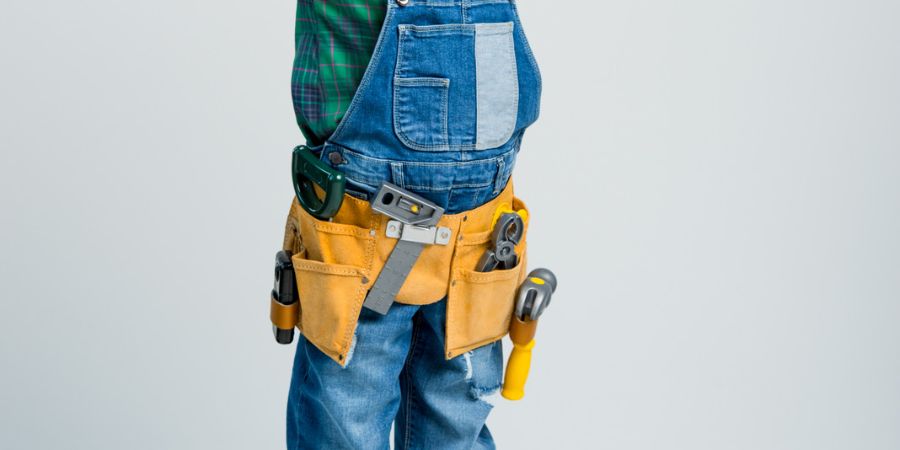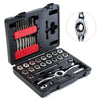
Get Your Child the Best Kids Tool Belt for Their DIY Projects
Introducing children to the world of DIY projects is an excellent way to foster their creativity, independence, and problem-solving skills.
One essential piece of equipment that can help your child feel like a true handyman or handywoman is a kids tool belt.
This article will guide you through selecting the best kids tool belt for your child's DIY projects and ensure their safety and enjoyment while they learn valuable life skills.
Table of Contents
- Why a Kids Tool Belt is Important
- Features to Look for in a Kids Tool Belt
- Top Kids Tool Belt Recommendations
- Additional Tool Belt Options
- Safety Tips for Kids Using Tool Belts
- Teaching Your Child Basic DIY Skills
- Conclusion
Why a Kids Tool Belt is Important
A kids tool belt serves several purposes when it comes to engaging children in DIY projects:
- Organization: A tool belt helps keep all of their tools in one place and within reach, which promotes organization and efficiency.
- Safety: By having a designated place for each tool, the risk of accidents caused by misplaced tools is significantly reduced.
- Responsibility: Wearing a tool belt encourages children to take responsibility for their tools and workspace.
- Confidence: Equipping your child with a proper tool belt can boost their confidence and make them feel like a real handyman or handywoman.
- Role-Playing: Children love to imitate adults, and wearing a tool belt can help them feel more engaged in the activity and enhance their role-playing experience.
Features to Look for in a Kids Tool Belt
When choosing the perfect kids tool belt for your child, consider the following features:
- Material: Look for durable materials like canvas, nylon, or leather that can withstand wear and tear.
- Adjustable Waist Strap: A tool belt with an adjustable waist strap ensures a comfortable fit and accommodates growth.
- Multiple Pockets and Loops: Ample storage for various tools and accessories is crucial for a functional tool belt.
- Size and Weight: The tool belt should be lightweight and appropriately sized for your child to avoid discomfort or strain.
- Age-Appropriate Design: Consider your child's age and skill level when selecting a tool belt with the appropriate number of pockets and compartments.
- Safety Features: Opt for tool belts with safety features such as reflective strips, secure closures, and reinforced stitching.
Top Kids Tool Belt Recommendations
Here are some top kids tool belt options to consider for your child's DIY projects:
Hi-Spec Children's Tool Belt
- Material: Hard-wearing, splash-proof fabric
- Adjustable Waist Strap: Yes, fits waist sizes 56-69cm
- Pockets and Loops: Multiple pockets and holders for easy organization
- Age Recommendation: 5-7 years (with adult supervision)
The Hi-Spec Children's Tool Belt is designed to inspire young builders with a complete set of real DIY hand tools, perfect for ages 5-7 years and above under adult supervision. This durable, splash-proof fabric tool belt features adjustable waist strap and multiple pockets and holders for easy access to all their essential tools, making them feel like true professionals.
Active Kyds Leather Kids Tool Belt
- Material: Leather
- Adjustable Waist Strap: Yes, up to 30 inches
- Pockets and Loops: 7 pockets, 2 loops
- Age Recommendation: 3-10 years
This high-quality leather tool belt offers durability and ample storage with seven pockets and two loops. The adjustable waist strap ensures a comfortable fit for children aged 3 to 10 years.
Grip Children's Tool Belt
- Material: Canvas
- Adjustable Waist Strap: Yes, up to 36 inches
- Pockets and Loops: 5 pockets, 1 loop
- Age Recommendation: 4-12 years
The Grip Children's Tool Belt features a durable canvas material and an adjustable waist strap that fits children aged 4 to 12 years. With five pockets and one loop, this tool belt provides sufficient storage for your child's essential tools.
Born Tough Kids Tool Belt
- Material: Nylon
- Adjustable Waist Strap: Yes, up to 32 inches
- Pockets and Loops: 6 pockets, 2 loops
- Age Recommendation: 5-12 years
This lightweight nylon tool belt is designed for children aged 5 to 12 years. It features six pockets, two loops, and an adjustable waist strap for a comfortable fit.
Melissa & Doug Wooden Tool Belt Set
- Material: Canvas
- Adjustable Waist Strap: Yes, up to 24 inches
- Pockets and Loops: 4 pockets, 1 loop
- Age Recommendation: 3-6 years
The Melissa & Doug Wooden Tool Belt Set includes a canvas tool belt with four pockets and one loop, as well as five wooden tools. This set is designed for children aged 3 to 6 years and encourages imaginative play.
Additional Tool Belt Options
To provide more variety, here are some additional kids tool belt options:
Stanley Jr. Tool Belt
- Material: Canvas
- Adjustable Waist Strap: Yes, up to 27 inches
- Pockets and Loops: 4 pockets, 1 loop
- Age Recommendation: 5-10 years
The Stanley Jr. Tool Belt is made from durable canvas and features an adjustable waist strap suitable for children aged 5 to 10 years. With four pockets and one loop, this tool belt offers adequate storage for basic tools.
My First Tool Belt by My First Lab
- Material: Polyester
- Adjustable Waist Strap: Yes, up to 30 inches
- Pockets and Loops: 5 pockets, 1 loop
- Age Recommendation: 3-7 years
The My First Tool Belt is designed for younger children aged 3 to 7 years. Made from polyester, it features an adjustable waist strap and has five pockets and one loop for storing essential tools.
ToughBuilt Kids Tool Pouch
- Material: Nylon
- Adjustable Waist Strap: Yes, up to 34 inches
- Pockets and Loops: 6 pockets, 2 loops
- Age Recommendation: 6-12 years
The ToughBuilt Kids Tool Pouch is a sturdy nylon tool belt designed for children aged 6 to 12 years. It features an adjustable waist strap, six pockets, and two loops for versatile storage options.
Related Article: Hand Tool Kits For Kids Under Age 9
Safety Tips for Kids Using Tool Belts
To ensure your child's safety while using a tool belt, follow these guidelines:
- Supervision: Always supervise your child when they are using tools or engaging in DIY projects.
- Age-Appropriate Tools: Provide your child with age-appropriate tools that are safe for them to handle and use.
- Proper Use and Storage: Teach your child how to properly use and store each tool to minimize the risk of accidents.
- Safety Gear: Equip your child with safety gear such as goggles, gloves, and ear protection when necessary.
- Tool Belt Maintenance: Regularly inspect the tool belt for damage or wear and replace it when needed.
Teaching Your Child Basic DIY Skills
Equipping your child with a proper tool belt is just the first step. To make the most out of their DIY experience, teach them basic skills and techniques:
- Measuring and Marking: Teach your child how to use a tape measure and mark measurements accurately.
- Cutting: Show them how to safely use scissors or age-appropriate cutting tools for various materials.
- Hammering: Instruct your child on proper hammering techniques, ensuring they hold the hammer correctly and strike with precision.
- Drilling: If age-appropriate, teach your child how to use a hand drill or power drill under strict supervision.
- Sanding: Demonstrate the correct way to sand surfaces by hand or using a sanding block.
Remember to start with simple projects and gradually progress to more complex tasks as your child's skills and confidence grow.
Conclusion
Investing in a high-quality kids tool belt for your child's DIY projects can help them develop essential life skills while having fun. By considering factors such as material, adjustability, storage options, and safety features, you can choose the perfect tool belt for your child.
Remember to supervise your child during DIY projects and ensure they have age-appropriate tools and safety gear.
With the right tool belt, guidance, and basic DIY skills, your child will be on their way to becoming a confident and capable DIY enthusiast.



